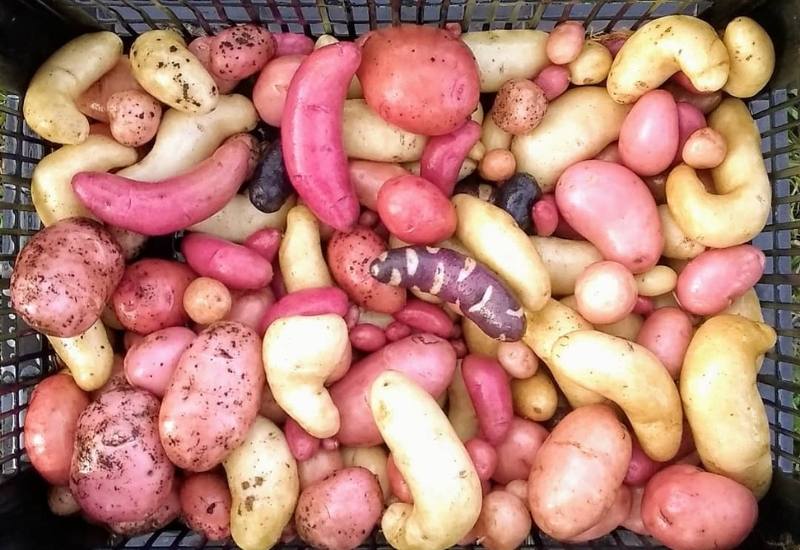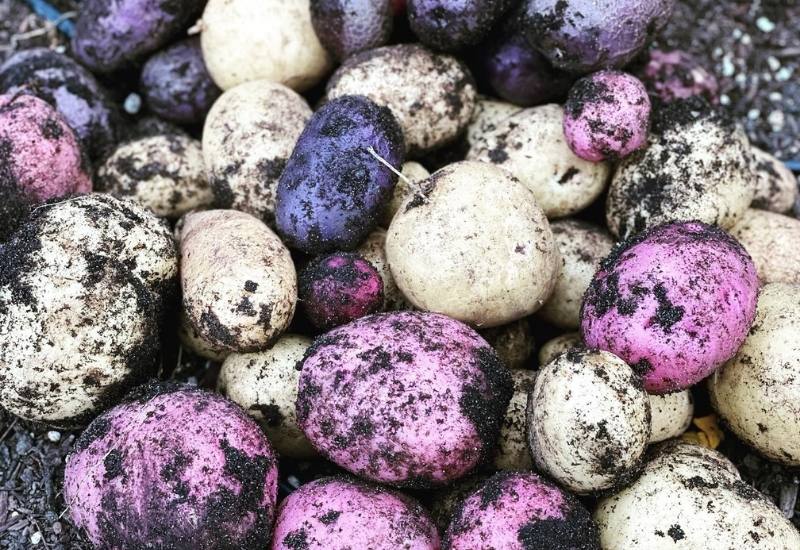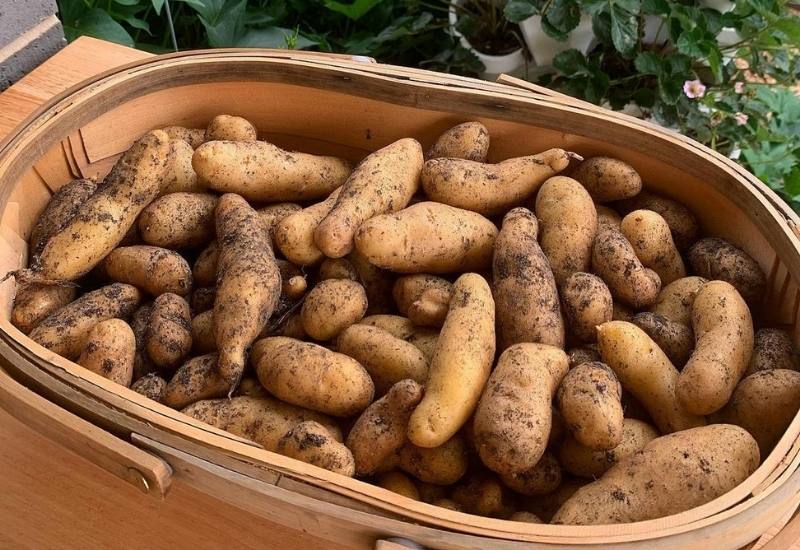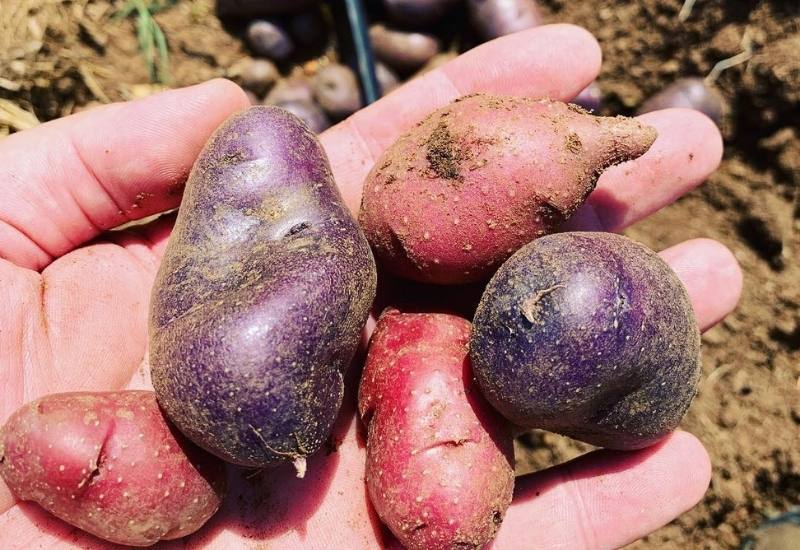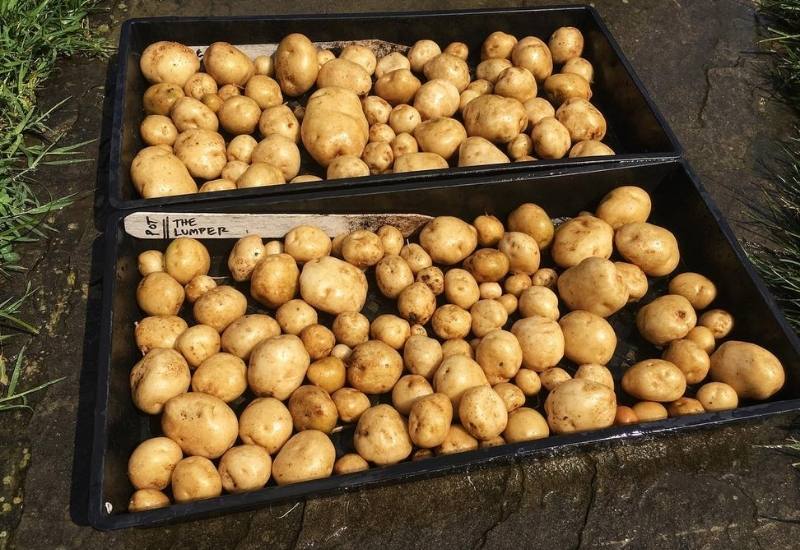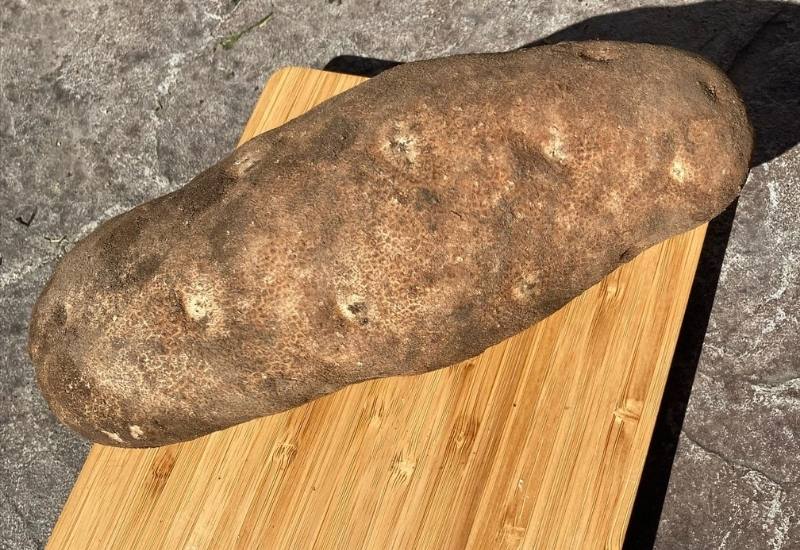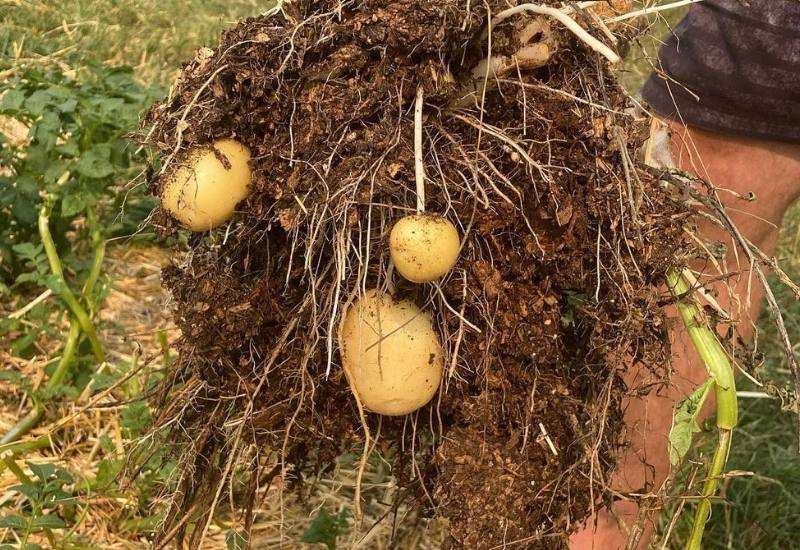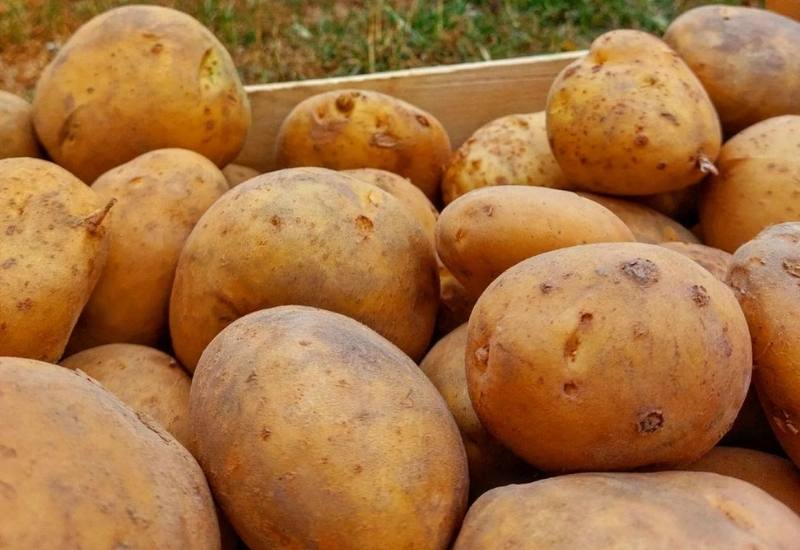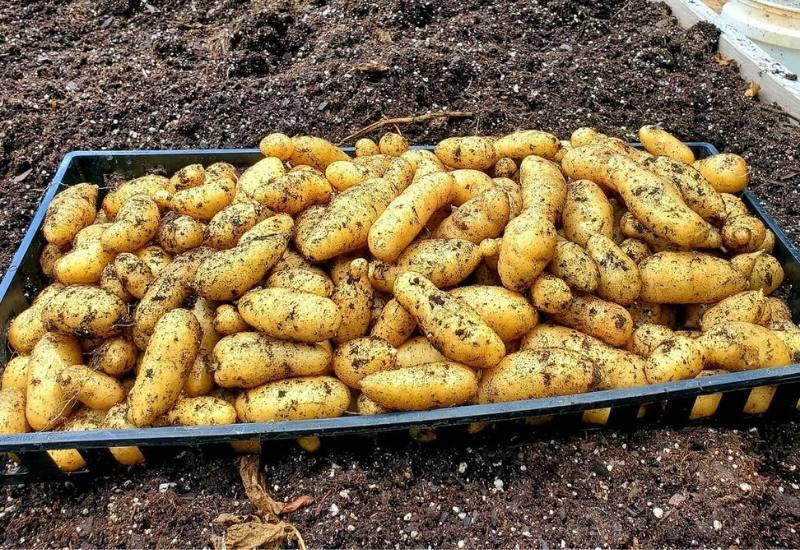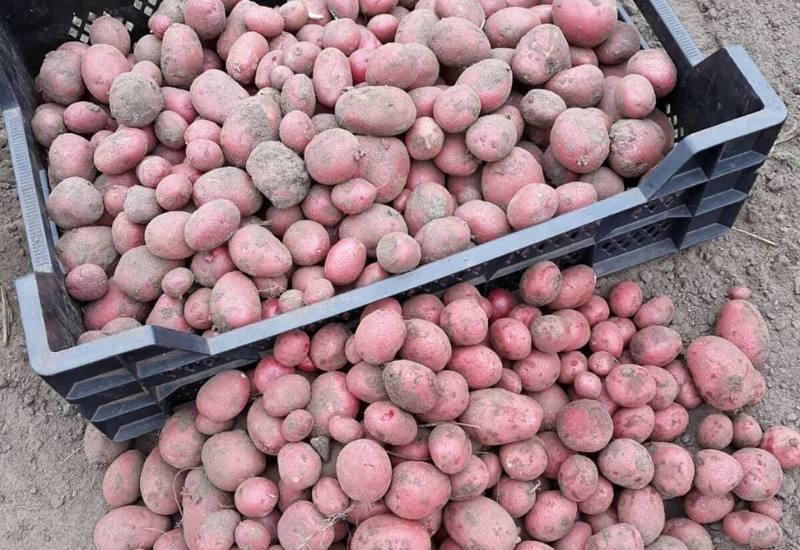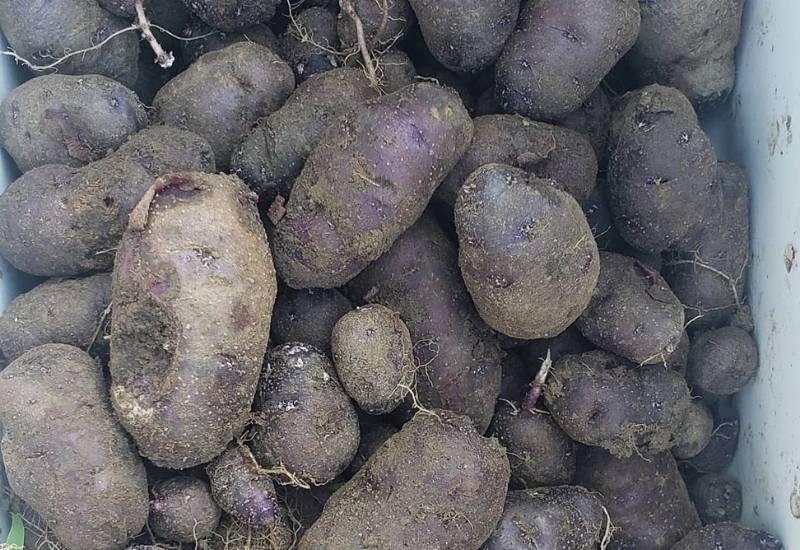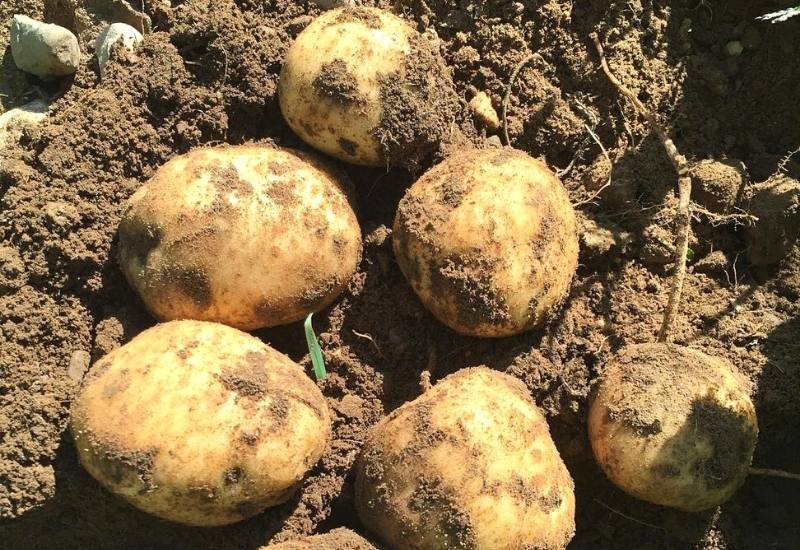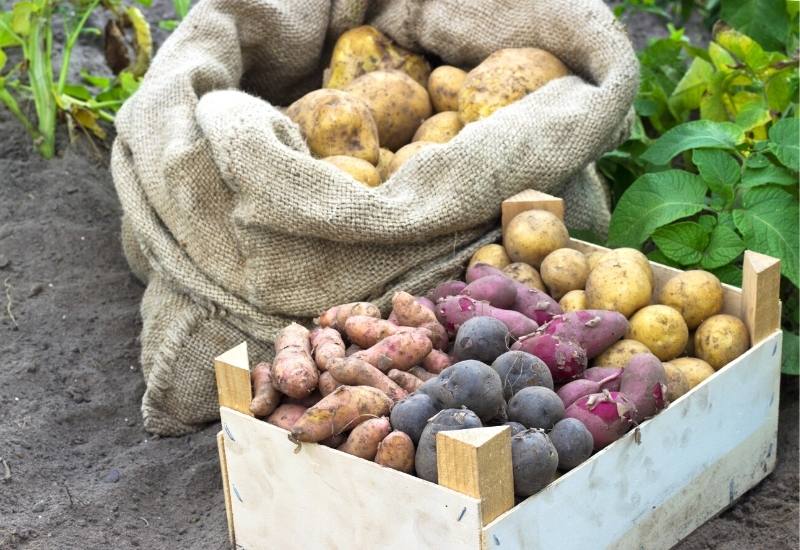
Potatoes, the unassuming root vegetable, have been a constant presence in kitchens and gardens for as long as anyone can remember. While the standard Russet, Red, or Yellow potatoes may be the norm in grocery stores, there’s a world of heirloom potatoes out there that have been grown for centuries that should be making a comeback in our gardens and farms. With their strange shapes and rainbow of colors, these old varieties of potatoes are as intriguing to look at as they are tasty to eat.
Just like heirloom tomatoes, there’s a growing fan base for these heritage varieties. And who can blame them? With a rich history and unique flavors, heirloom potatoes are worth the hype.
So, what’s the deal with these special spuds? What makes an heirloom potato an heirloom, you may ask?
Most horticulturists classify potatoes as “heirloom” only if it has been in existence for at least 100 years and has remained genetically unaltered since then or a variety that has not been genetically modified for at least 50 years. In general, most heirloom potato varieties were developed in the late 1800s when potato crops were decimated due to potato blight.
The characteristics of heirloom potatoes can vary widely, with different varieties exhibiting unique flavors, textures, and a stunning array of colors. Some noteworthy heirloom potato varieties include Peach Blow, Russet Burbank, German Butterball, Bintje, Champion, Russian Banana Fingerling, Garnet Chile, Rode Eersteling, Russian Blue, and Green Mountain.
Now, I must warn you that heirloom potatoes may not be as hardy as some of the newer varieties, but their over-the-top flavor is what makes them worth growing. And if you’re interested in trying your hand at growing some of these special spuds, I’ve got you covered with the top 10 heirloom potato varieties and how to grow them in your home garden. Trust me, your taste buds will thank you!
Get to Know Heirloom Potatoes
The origins of potatoes are traced back to Peru where they were first cultivated over 4000 years ago. They spread through Europe and the rest of the world but the unique characteristics of these traditional potatoes were slowly lost in favour of uniform varieties that can be grown in large fields.
Unfortunately, with genetic uniformity came susceptibility to issues as can be seen by the Irish potato famine that killed over a million people and displaced just as many.
Yet throughout history, dedicated farmers and gardeners have carefully saved our rich history of potatoes and passed the old varieties on to future generations. These carefully preserved varieties are the heirloom potatoes that we grow today.
What Heirloom Means
Heirloom means different things to different people. There are also a lot of different terminologies and people also use the terms heritage, traditional, antique, classic, or vintage in exchange for heirloom.
Some people say heirloom varieties are the varieties that their grandparents grew, while others claim a potato variety must be hundreds of years old to be considered an heirloom.
While there is no clearly defined definition, most people now assume that heirloom potatoes refer to any cultivar that is more than 50 years old.
To me, an heirloom is most any potato that has not been bred for mass production or large-scale farming. I consider any potato is grown exclusively for its taste, quality of fruit, unique size, or colorful flesh to be an heirloom.
What Makes Heirloom Potatoes So Special?
So what’s all the fuss about heirloom potatoes? What’s so wrong with the new varieties?
While new potato varieties have their place, there are many reasons to grow heirloom potatoes:
Heirloom Seed Potatoes VS Potato Seeds
Like all potatoes, heirloom potatoes can be grown by either planting seed potatoes or potato seeds.
Seed potatoes are basically a potato that you plant back in the ground and they will regrow an entire new potato plant. This is the best way to grow heirloom potatoes as it guarantees that the new potatoes will be the same as the parents were.
Potato seeds are small, round berries that are produced from a potato flower. These berries contain seeds that you can plant and grow potatoes. However, potatoes are not true to seed, meaning the seeds from the berries will not produce the same kind of potato.
In most cases, heirloom potatoes are all grown from seed potatoes to ensure that the unique qualities of the potato are carried on.
Problems With Heirloom Potatoes
Because potatoes are typically produced from tubers rather than seeds, it is much more difficult to maintain healthy potato genes and varieties for long periods of time and you can sometimes run into problems with passing on diseases.
For example, viruses do not usually pass from one generation to the next when a vegetable that is propagated from seeds.
However, because potatoes are typically propagated vegetatively by planting tubers from the previous crop, diseases can easily be passed on until an heirloom variety becomes such a problem that it is no longer worth growing that variety.
One of the best features of heirloom potatoes is that you can buy some from a farmer’s market and use them to grow your own potatoes. It also allows you to swap and trade with friends to introduce new varieties into your garden.
However, since potatoes are notorious for passing on diseases through their tubers, you can potentially run into problems with such informal growing especially after several years of cultivation.
Where To Buy Heirloom Potatoes?
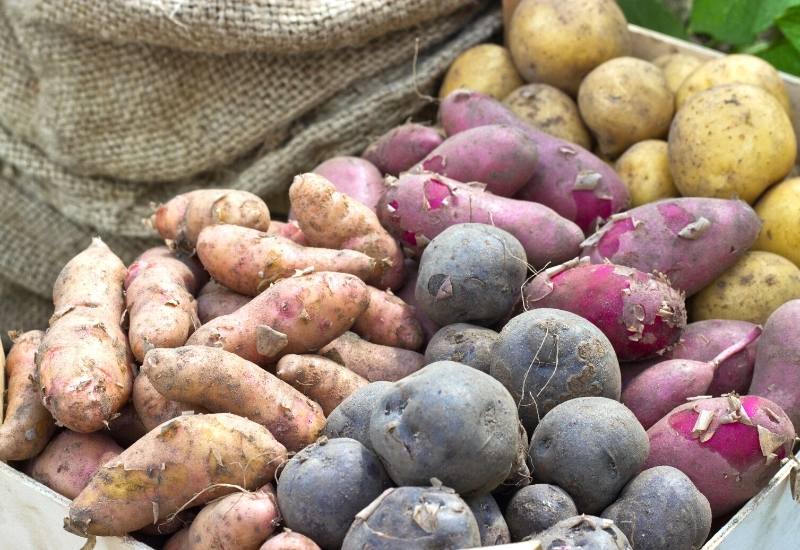
To avoid any chance of passing on diseases and other genetic issues, make sure to buy your heirloom seeds from reputable sources which ensure careful and disease-free cultivation, such as
Seed Companies
Most seed companies will only sell high quality, disease-free tubers. Make sure you do your research to make sure they are reputable or certified. Some seed companies, such as Baker’s Heirloom Seeds, or Annie’s Heirloom Seeds specialize in heritage cultivars for the home or market garden.
Potato Breeders
There are many seed-saving organizations that work hard to protect the vitality of heirloom seeds, including potatoes. Seeds of Diversity Canada is one such organization, and these organizations often have lists of certified breeders that you can contact.
Government Organizations
Many agriculture extension offices work to maintain healthy genetics of potatoes. While these agencies usually work with seed companies, they will usually be able to point you in the direction of a good quality potato grower where you can find certified healthy seed potatoes.
Planting, Growing, and Harvesting Heirloom Potatoes
Here are some pointers to successfully preparing and growing heirloom seed potatoes:
Choosing and Preparing Heirloom Seed Potatoes
Most potatoes are divided into three groups, namely early season, mid season, and late season. This refers to how long the potatoes take to mature.
Early season mature in 60 to 80 days, mid season generally take 70 to 90 days, while late season need between 90 and 120 days on average to produce their tubers.
Potato plants sprout from the eyes of a potato with each eye turning into an above ground stem. On average, you want between 2 and 4 eyes per seed potato.
If your potatoes are large with numerous eyes, they can be cut into smaller pieces. Many potato growers recommend chitting your potatoes, which is the practice of letting the eyes sprout prior to planting.
Planting Seed Potatoes
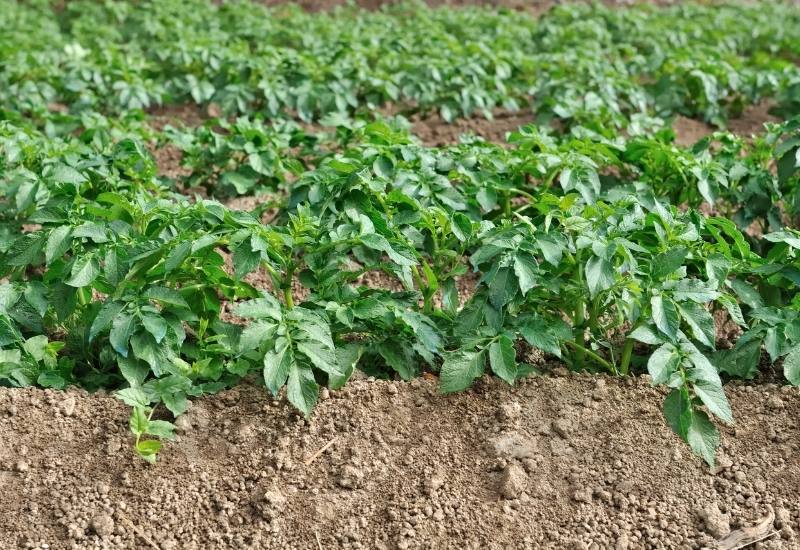
There are different schools of thought on planting potatoes. Perhaps the most common is trenching the potatoes, which is where you did a hole or trench about 30 cm (1 foot) deep, place the seed potato in the bottom, and then cover it with 8cm to 10cm (3-4 inches) of soil. As the potatoes grow, hill the potatoes by continuing to fill in the trench.
We like growing potatoes in cages. We erect temporary frames of lattice or wire and bury the seed potatoes just 8cm to 10cm (3-4 inches) inside the frames.
As the potatoes grow, we hill them with soil, compost, or (our favorite) straw. At harvest time, simply take down the frame, pull up the straw, and most of the tubers can be easily picked up.
Space your potatoes about 30cm (1 foot) apart. If you need to walk amongst your plants, space your rows about 1m (3 feet) apart.
Harvesting Heirloom Potatoes
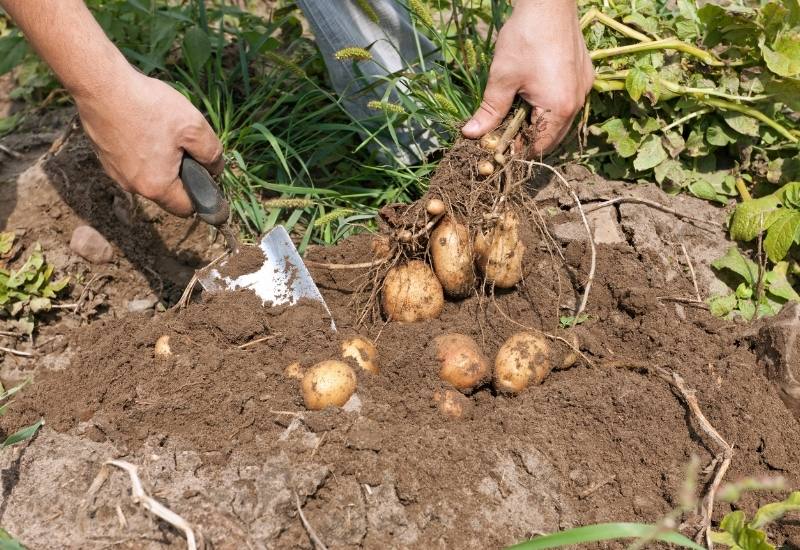
All potatoes require careful digging to avoid damaging the tubers. But heirloom potatoes can have particularly delicate skins, so these types should be handled with extra care.
A garden fork is preferred for digging potatoes over a shovel. Make sure to plunge the fork into the ground far enough from the base of the potato plant to avoid spearing any of the tubers. Then push down on the handle to loosen the soil and gather any tubers that emerge.
Storing Heirloom Potatoes
Brush off any dirt from your potatoes with your hands, but do not wash them. Do not scrub to vigorously or you can damage the soft potato skins. For long-term storage, cure the potatoes by spreading them out in a single layer in a dark ventilated area for 1 to 2 weeks.
TIP: Curing them on seed trays keeps them off the ground and allows air to circulate to prevent rotting. It also gives a second use to your seed trays which often sit unused during the harvest season.
Once cured, we store our potatoes in cardboard boxes filled with shredded paper (who knew those old bank statements were good for something!). Make sure to punch holes in the box for air circulation.
10 Outstanding Heirloom Potato Varieties For The Home Garden
While there are numerous heirloom potato cultivars out there, here are 10 of our favorite heirloom potato varieties that you can grow in a home or market garden.
1: Peach Blow
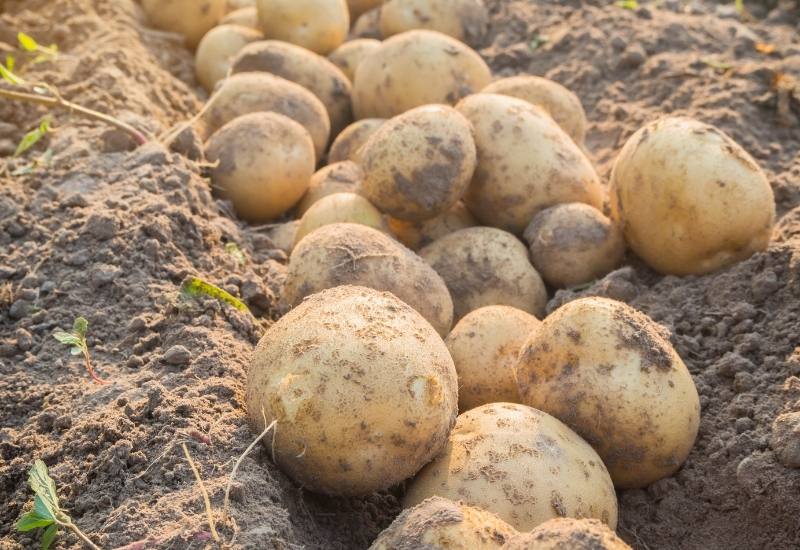
Cultivation Since: Pre 1850
This is one of the oldest full-sized heirloom potatoes still available, possibly originating in 1841 in New Jersey. The beautiful flowers are a soft peach-pink and the tubers are small with exceptional flavour.
There have been several later versions of this potato such as Thorburn’s White Peach Blow or Bliss’ Improved Peach Blow which have been bred to improve characteristics such as yield.
2: Russet Burbank
Cultivation Since: 1876
Late Season
Developed from the Early Rose, this early russet is an excellent producer that can grow very large and is a classic for baking and French fries.
They can be tricky to grow, and many need lots of consistent moisture and loose sandy soil. Typically grown in Northern climates, Russet Burbank are one of the most commonly grown potatoes in North America.
The flowers are white and the potatoes are a classic russet brown. The potatoes also store very well for long periods. The new strains available today are fairly resistant to a variety of diseases.
3: German Butterball
Cultivation Since: 1988
MidSeason
Even though they have only been around since the late 80s, German Butterball are usually considered and heirloom potato. Not only was it developed from pre-19 Century stock, it also has all the amazing characteristics of one has come to expect from heirloom potatoes.
As the name implies, the texture is so creamy that you don’t have to add butter, and seasonings are unnecessary for the great flavour.
The tubers are yellow-gold with a firm waxy texture that average 10cm to 12cm in length. They can be cooked in a variety of ways including mashing, baking, frying, and potato salad.
4: Bintje
Cultivation Since: 1910
Mid to Late Season
Developed in the Netherlands, Bintje are smallish round potatoes with yellow/gold flesh and skin. They have a very unique flavour and are typically best roasted or made into French fries.
They keep quite well with a low rate of sprouting. They are unfortunately more susceptible than other heirlooms to diseases, especially late blight, so make sure to take extra precautions if your area is susceptible to these issues. The flavour will be worth the careful cultivation.
5: Champion
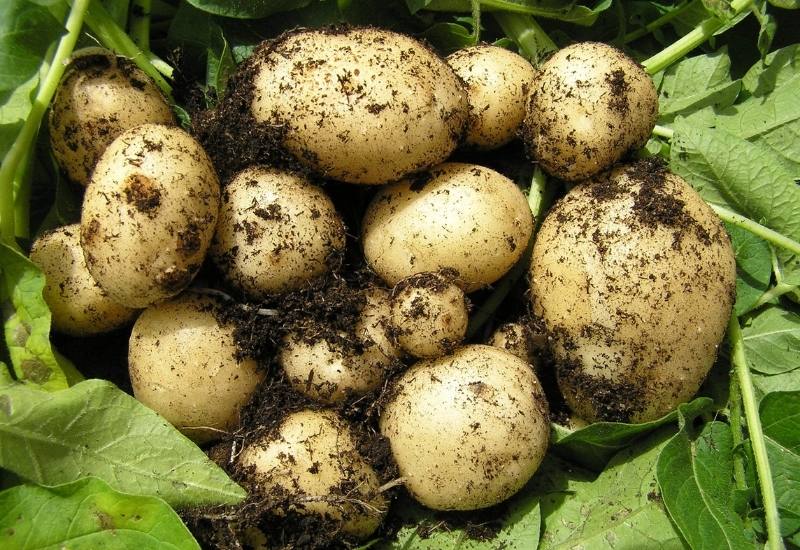
Cultivation Since: 1881
Mid Season
This is one of the greatest new potatoes you can eat, the champion came from Scotland and quickly spread due to its high resistance to devastating blight.
It has white skin and yellow flesh and it is best boiled in its skin and used in salads. Even so, its texture and flavour are excellent no matter how you cook them.
6: Russian Banana Fingerling
Cultivation Since: 1700s
Late Season
A very early heirloom potato, this fingerling potato has a distinct banana shape. The 6cm to 7cm (3-4 inches) long tubers havebrown skin and yellow-gold flesh.
The skin is very thin making peeling unnecessary and the potatoes have a nice waxy texture that is excellent for salads, but they are also very good boiled, baked, and fried.
Russian Banana Fingerling were developed in the Balkans, and were probably spread around the world by sailors and fur traders.
A staple for any heirloom potato grower, Banana Fingerling and readily available and the light pink flowers are a pretty addition to the garden. They are also a heavy producing plant and the tubers are relatively good keepers.
7: Garnet Chile
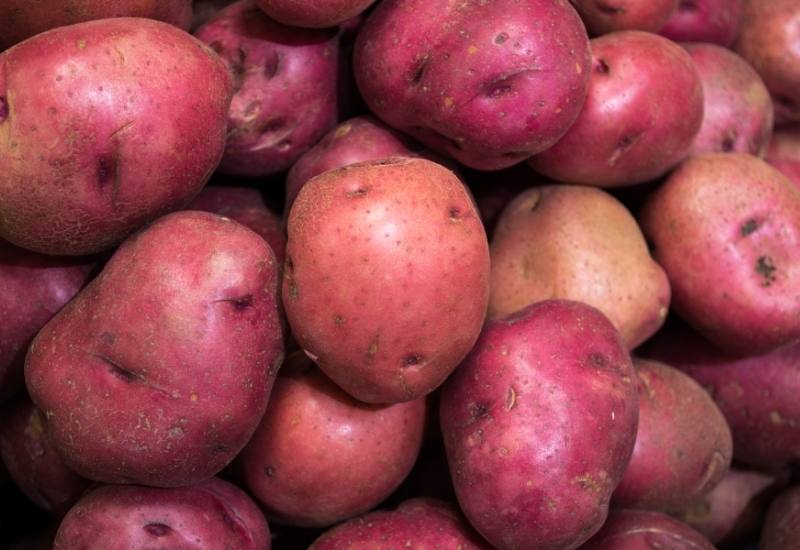
1853
Late Season
This is the father of many of the potatoes we enjoy today. After the devastating potato famine in the 1840s, seed stock was brough from Chile and the result was the Garnet Chile.
It is a spherical, small pink potato which keeps very well and is excellent boiled or used in salads. The flower is white, though some serious potato growers have found that it has never flowered in their garden.
8: Rode Eersteling
1892
Early Season
This early (firstling) yellow potato has a nice balance between waxy and floury textures. Bred for exceptional flavour, they are not meant for keeping so make sure you eat them up as boiled or fried potatoes.
While this variety is a yellow potato, there are also red and pink variants that have been discovered which are just as delicious.
The plants have an average yield and are fairly resistant to scab.
9: Russian Blue
Pre 1900s
Late Season
Another variety from Russia, this is perhaps the most striking blue potato you can get, and the aesthetics on the dinner table are well worth it.
The skins are deep purple and the flesh is a dark blue which remains after cooking. They have a similar texture to Russets so are ideal for baking, mashing, or frying.
They are a very heavy setting potato, so make sure to give it lots of room while it is growing. Russian Blue are also very drought resistant and can handle lack of water better than most other spuds.
Not only are the potatoes striking, but the flowers are also a delicate purple.
10: Green Mountain
1885
Late Season
Many claim the Green Mountain is a great all-round variety. This high starch potato is great for gratin, potato pancakes, and even potato chips, but it also holds together well when boiled and becomes a bright snow white.
Green Mountain has a pretty white flower, and the tubers are oblong with tan skin and white flesh. They are, unfortunately, susceptible to late blight, but they are very good keepers.
Conclusion
All too often these days, agricultural practices rely on modern techniques and newly developed cultivars. Most of these modern practices including spraying and excessive tilling, are damaging to the environment while the modern cultivars create a monocrop system that is unsustainable.
We need to move back to old-school practices that our ancestors followed, and what better way to start than by growing some of the potatoes that they themselves grew?
While many heirloom potato varieties are dying out and others are becoming extremely difficult to attain for the home grower, I hope some of the varieties listed above will bring healthy, vitality, and a little bit of history into your garden.

Written By
Amber Noyes
Amber Noyes was born and raised in a suburban California town, San Mateo. She holds a master’s degree in horticulture from the University of California as well as a BS in Biology from the University of San Francisco. With experience working on an organic farm, water conservation research, farmers’ markets, and plant nursery, she understands what makes plants thrive and how we can better understand the connection between microclimate and plant health. When she’s not on the land, Amber loves informing people of new ideas/things related to gardening, especially organic gardening, houseplants, and growing plants in a small space.

